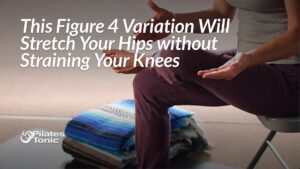I can’t begin to tell you how excited I am about today’s video. I’ve been wanting to make a video with this exercise for a very long time!
Today you’re going to connect to the deepest muscles in your back, your multifidus.
When I first discovered this connection in my body, light bulbs of understanding went off for me like never before. And when I put this connection into the Pilates work I was already doing, big changes started to happen and I got more value out of every single Pilates class and session I took.
In fact, it’s actually the multifidus connection that I credit with gaining back two inches of height that I thought I’d lost forever due to my scoliosis.
But, my absolute favorite thing about the exercise in this video is that you can do it anywhere—and no one can tell you’re doing it! The only way anyone will know is if you suddenly get taller right before their eyes. By the way, that is actually a possibility. 😉
Now, if you don’t feel this connection right away, be patient with yourself and don’t give up. Some people feel it right away while others have to imagine it and see it in their minds for a while before it clicks.
It’s also not unusual to feel it all in your deep abdominals. The multifidus and your transverse abdominis are a team. So if you're feeling deep abdominals, it's a good sign that you've found your multifidus, you just might not sense the connection in your back yet.
If you’ve never felt your multifidus before, it’s a much different feeling than your typical muscle contraction. It's a deep feeling on the spine. These muscles swell (in a good way) to hug your spine when they’re engaged.
The multifidus responds really well to imagery. So even if you’re not feeling anything, using the imagery will still help you to get great results. Eventually, with practice you’ll begin to sense the multifidus connection in your body.
So give this one a try and let me know how it goes in the comments below the video!
See you in the studio,
Sydney





20 Responses
Hi Sydney,
I love this version of Rebecca’s elevator. Lovely, clear and easy-to-follow directions. I’ll tell all my clients to have a look at your video.
Thank you Regan! I truly value your feedback. It’s great to hear from you. I hope you are doing well!
Thanks for the awesome read! I’m wondering if this is really good for someone with Adult Scoliosis? thanks
Hi Judy,I’m glad you enjoyed the post! The elevator exercise is wonderful for someone with scoliosis. Thank you for your feedback.
Hi. This was interesting. I have always been taught the pelvic elevator for the pelvic floor and TA connection and never in relation to the multifidus. This is a new concept for me. I’ve had a go and I think I get it, but would like to clarify. What should be happening in the placid floor and TA region as you perform this elevator? As I try to feel the elevator in my multifidus I am also feeling the TA smile. I think this is what you would expect, but just want to check. Are you expecting clients to be able to isolate multifidus? I hope not 🙂
Hi Caroline, What you are feeling is perfect. The multifidus, TA and pelvic floor co-activate. The multifidus leads the way, so when you activate your multifidus, the TA and PF automatically come along without even having to ask for them. Thanks for your feedback and question!
Hi Sydney! I’ve finally gotten connection to my Multifidus & TvA! I ended up having the connection when doing very slow and steady single bridge marching with a concentration on breathing. I do feel taller! And my sciatica and pelvic floor problems are calming down! So glad to see someone out there who doesn’t go by the old school of thought “navel to spine”. Thank you.
That’s fantastic Daniel. Thank you for your feedback!
Hi Sidney!
I tried the exercise and, although I feel my TA, I only sense the multifidus in my lower back. Wherever I’m trying to contract the upper portion of the multifidus I feel my scapulae separate. Is this ok? I actually notice my upper back enlongate, but maybe I’m contracting another muscles.
I’m also have a doubt about how to use the multifidus in everyday life. Do you keep it contracted at all moments? Or only in training sessions or when carrying weight?
Hi Ivån, Everything you describe sounds spot on, especially if you are used to squeezing your scapulae together as a response to standing up straight. It’s fantastic that you’re feeling your upper back elongate! When your spine is in optimal alignment, ideally, your multifidus will turn on without having to think about it. But, while you’re in the process of learning what your optimal alignment feels like, this exercise is great to do a couple times a day, during training session or before lifting weights.
Thanks for your feedback!
Great article! Love the way you write it is so easy to understand especially since I am new to pilates.
Thanks Danielle, I’m glad you found the article helpful!
Hey Sydney, As someone with frequent episodes of back spasms, I stumbled upon your website while searching the web about the multifidus that my physio said wasn’t probably working optimally for me. I’ve tried the elevator, and I don’t really feel it much in my fingers though I ‘think’ I sense it when i really concentrate hard and ‘visualize’ the muscles being activated on the exhale. I do feel the TA alright! Quick question – what should be the length and frequency of these drills?
Hi Sunil, Sensing the multifidus can be super subtle at first. It’s a great sign that you feel your TA and the visualization is key, so way to go!
You could practice this connection two-three times a day for 10 inhales and exhales. As time goes on it will become easier to feel and require a less concentration to find.
Thanks for your question!
I am new to Pilates and have been frustrated and struggling in classes due to lack of specific cues to engage the core. With your videos and explanations I have something to help me practice and learn engagement so I will not waste my time in class. I am so grateful to you Sydney. Wish I could attend your studio…I am in NY so it is not possible
Thanks so much for your feedback Amy! I’m thrilled that the blog posts have been helpful! 🙂
This technique is amazing. I have 2 points i’d like to add.
-Manual activation is really only needed for the lumbar part of the multifidus. The thoracic area will not be inhibited so can be trained without manual activation. This makes actually performing the technique a couple of times a week that much easier (after all there are alot of other muscles to train.
-While it is true that breathing is important when training the multifudus, it isn’t strictly required during the activation part. again making it more comfortable and less of a hassle to perform and perfect this technique. I personally save the breathing part for when i perform the tabletop exercise (after performing this activation).
Thanks for sharing this technique it helped me alot
Thanks for sharing, Mathieu! I appreciate your feedback!
Love yr explanations and imagery, very clear and easy to imagine. I like using it with the breath. I would love to come to your classes but I’m in Ireland. Thank you anyway. I look forward to following you on here. One love. sheela.
Thanks so much for your kind feedback, Sheela! And I’m thrilled this imagery resonated with you. I do have an online membership you might like to check out. Here’s a link with more info:
https://pto.pilatestonic.com/
If you sign up for the waitlist, you’ll be the first to know when the membership opens again for new members. Thanks again for sharing!